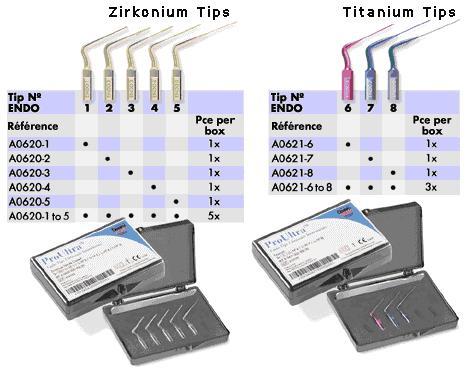
InformationPrimary endodontic treatment Endodontic retreatment Special treatments Endodontics step by stepProduct catalogueOrder and payment information Previous special offers Hand instruments Rotary instruments Operating Microscope General instruments Accessoires Filling materials MiscellaneousRemainingReferences Site map Presentations (RECOMMENDABLE!) Downloads Het Kanaal Links Endoplaza Forum MarketPlaza About Endoplaza Instructions for use website
|
Ultrasonic equipment/filesWhen talking about the present endodontic (re)treatment and the corresponding complications, it is impossible to imagine life without ultrasonic equipment. However, to prevent frustrations the disadvantages should be recognised. Below we explain in which situations the ultrasonic equipment can be used and what the pros and cons are. Ultrasonic equipment for endodontics can be divided in five main groups:
Ultrasonic files for the cleaning of root canalsUltrasonic files work with a frequency of at least 2500 Hz. Their vibration creates cavitation of the liquid (Natrium hypochlorite), which causes micro flow of the liquid in the root canal. In this way the grease layer can be more easily removed. Moreover the temperature of the liquid rises so that the dissolving effect of the hypochlorite improves. In a bent root canal the effect of the ultra sound is worse so the file should be bent in advance. Titanium niobium files (Satelec, Niobium Endo Kit) need not be bent in advance. The big issue is that almost all canals are bent and that the direction of the bend is very often not visible. A thin file causes more cavitation than a thicker file (it jams earlier in the canal). Advantages ultrasonic cleaning: thorough cleaning of the root canal. Attention: Without a doubt the tip of steel files can easily break off (but can simply be removed with a magnetic made hand plugger). Do not keep the file too long on the same place as this may have irreversible consequencies. Ad B: Ultrasonic files for the cleaning of root canalsThere are various ultrasonic tips with different lengths and diameter (ProUltra/Dentsply) which are fit for both EMS and Satelec. Because of their length it is possible to loop alongside the tip with the help of the operating microscope and to see where the point does its work. There are manufacturers who strongly advise against the removal of ultrasonic instruments if no use can be made of the operating microscope. To come at the broken instrument, one often makes use of a Gates Glidden Drill, the point of which is grinded off. Of course you measure beforehand at which depth the broken instrument lies. When an ultrasonic instrument is held against broken NiTi files, often pieces fly off the files. Really vibrating loose occurs rarely. A simpler way to remove NiTi files is with the aid of 006 files. Click on the camera to see a short movie of the procedure. (about 5 minutes; attention: the size of the file is 13 Mb in connection with the download time.)  Sufficient time should be spent on the removal of a broken instrument. Haste can cause even bigger disasters! Advice: do not use ultrasonic tips without good visibility (operating microscope). The risks are too great! Ad C: Ultrasonic tips for the shaking loose of root posts or tough root canal cementFor this purpose you need solid shorter tips. It is often necessary to apply more energy in order to exert sufficient power on the root post. This transfer of energy makes that the post gets warm. This may be painful for the patient. Therefore, in these cases it is wise to use water-cooling (at least water in the pulp chamber). Before the energy is constantly transferred to the post, first the cement around the post should be vibrated loose. A radix is often a little bit oval and with the operating microscope you can see well where with minimal danger for perforations it can be worked towards apical. Most posts have come loose after 10 minutes or less. Tip: There is a possibility that micro fractures appear in the radix. It is recommendable to inform the patient about the risks. Ad D: Ultrasonic tips for the removal of dentine to trace canal entrancesThese are tips which look like the tips for the removal of root posts as far as the effect is concerned. However, they have a round tip with diamond coating which resembles a round drill. Due to length and the design of such tips you can remove dentine with a good visibility (with the aid of the operating microscope). Attention: If you doubt whether you take off at the right place, this instrument is not without risk. It draws its own trace in the pulp chamber floor. The differences in colour are less well visible! Ad E: Ultrasonic tips (retrotips) for the surgical endodontics (the apex resection)After resection of the apix, in the direction of the longitudinal axis of the teeth element the root canal can be cleaned 3 mm (= the length of the retrotip). An important advantage in relation to the conventional technique with a drill is that a command has not or hardly to be done. Canals must not be cut too deep into the dentine in order to minimise the risk of leakage from the canal to the periapical area. Moreover, much less bone has to be removed than it would be the case in the conventional way. Because of the vibration minifractures can arise in the radix. It is not impossible that small pieces break off from the apical dentine/cement. A careful preparation in the centre of the root canal is a must. Ad F: Ultrasonic spreaders for the thermal compaction of gutta-perchaPractice has shown that the density of the gutta-percha in a root canal is bigger when use is made of this technique. Moreover, this is not the technique yhat is most widely recommended internationally (see Obtura II and System B) Pro Ultra endodontic instrumentsThese Endo Tips are fit for use in the ultrasonic scalers of Satelec and EMS. This is a complete set of 5 stainless steel ProUltra Tips coated with Zirkonium oxide except for Tip number 1 and 3 instruments, which are made of Titanium. 
The Titanium ProUltra Endo Tips 6-7-8 instruments have a long and subtle design. Therefore they are very fit to give careful shape to the root canal at places where there is little space. When you use these titanium tips we advice you to use them only under enlargement. These tips are used with a sweeping move and without water-cooling. De meer abrasieve Zirkoniumoxide ProUltra Endo Tips 3-4-5 zijn feitelijk bedoeld om in respectievelijk het coronale deel, het middengedeelte en het apicale gedeelte van het kanaal te gebruiken. Uit de praktijk blijkt echter dat de keuze voor een tip wordt bepaald door de gewenste lengte en diameter. De Endo Tips 2 t/m 5 zijn toepasbaar in het gehele wortelkanaal. Tip 1 is voorzien van een bolletje, bedoeld voor condensatie van cementen of om stiften enz. los te trillen. Deze tips worden gebruikt met een vegende beweging en zonder waterkoeling. The advantages of ProUltra Endo Tips
|